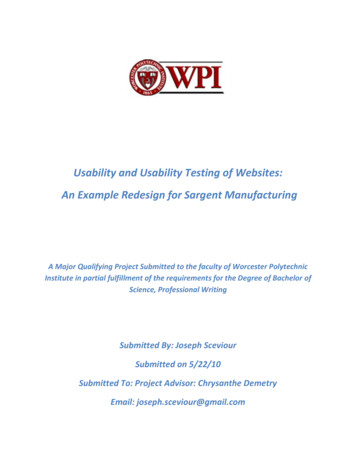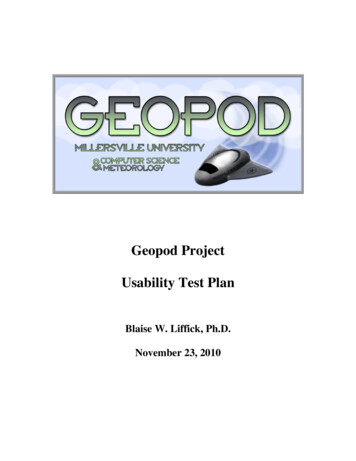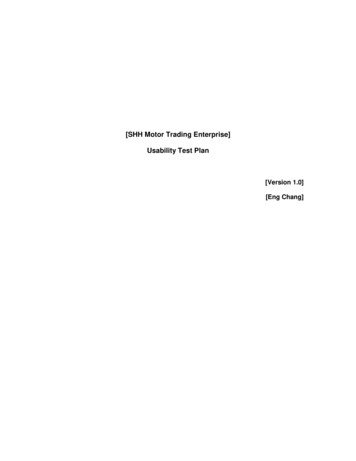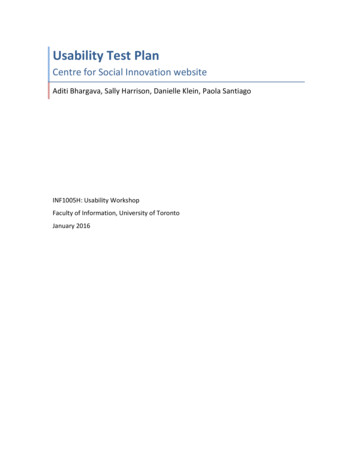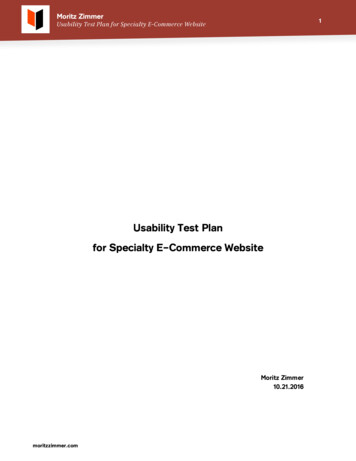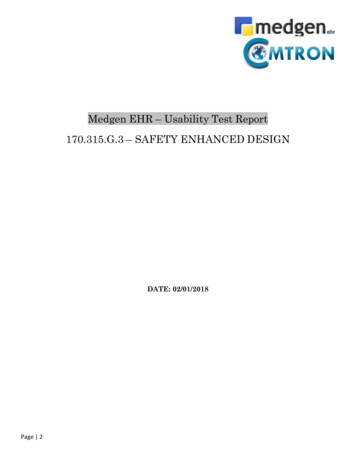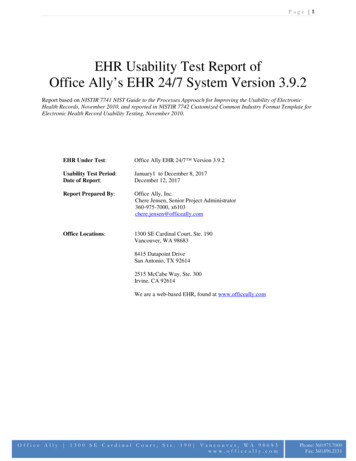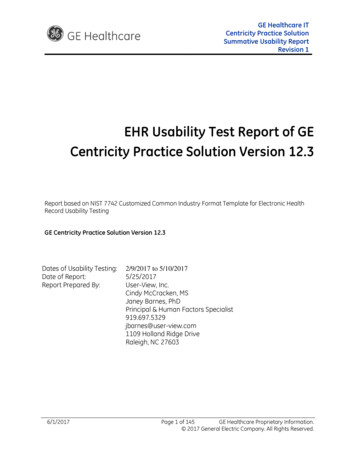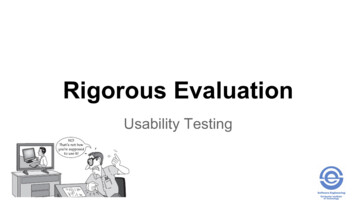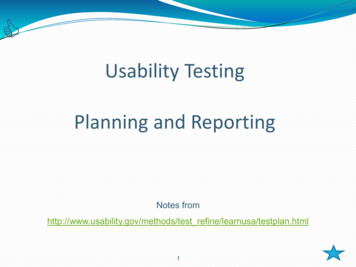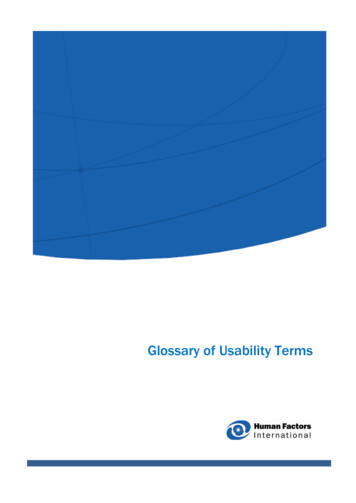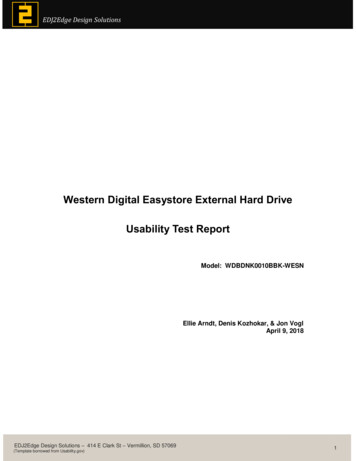
Transcription
EDJ2Edge Design SolutionsWestern Digital Easystore External Hard DriveUsability Test ReportModel: WDBDNK0010BBK-WESNEllie Arndt, Denis Kozhokar, & Jon VoglApril 9, 2018EDJ2Edge Design Solutions – 414 E Clark St – Vermillion, SD 57069(Template borrowed from Usability.gov)1
EDJ2Edge Design SolutionsTable of ContentsExecutive Summary . 3Background Information. 4Product Description . 4Test Objectives . 4Methodology . 5Participants . 5Procedure . 5Usability Tasks . 6Usability Metrics . 8Results . 9Completion Rate . 9Error-Free Rate . 10Time on Task . 11Subjective Measure: SUS . 12Recommendations . 13Problem Severity . 13Conclusion . 15References. 15EDJ2Edge Design Solutions – 414 E Clark St – Vermillion, SD 57069(Template borrowed from Usability.gov)2
EDJ2Edge Design SolutionsExecutive SummaryThis report contains the results of a laboratory-based user study conducted toevaluate 5 participants’ out-of-box experience with the Western Digital EasystoreExternal Hard Drive. The objectives of this study include evaluation of the product todetermine whether the external hard drive fit the description of “plug and play” aswell as whether the core features of a typical external hard drive were executableboth effectively and efficiently by its users.HardwareMaintain – The device packaging was appropriate in that it was not excessive andusers did not have issues or commit errors when unboxing and first connecting thedevice to the desk top. Regarding the ability of users to “plug and play,” users wereable to “plug” effectively and efficiently.SoftwareMaintain – The Western Digital Easystore External Hard Drive provided the user easyaccess to the installation program for the WD Discovery software in a way that wasboth optional and easy to understand. Most participants were able to upload anddelete files to and from the hard drive using the file explorer provided by theWindows operating system. Users were also able to check the available spaceremaining on the hard drive in multiple ways, allowing freedom of use of the device.Improve – The software used to interact with the product proved to be troublesomefor various reasons for each user. The installation of WD Backup software was notintuitive for most users. The WD Backup software was labeled as an “App” in theWD Discovery software interface, causing users to overlook the most obvious way toperform the task. WD Backup was not actually needed to backup and upload filesonto the hard drive, but it is required to complete the scheduling of an automaticbackup plan. Users had difficulty locating the correct software, WD Utilities and WDBackup, to set a sleep schedule and a backup schedule for the device, respectively.When attempting to disconnect, the device was still considered to be “in use” evenwhen the software was closed – users had to explicitly exit the software in order tofollow Windows protocol to disconnect the device.Negative findings are accompanied by recommendations that conform to theevaluation to improve effective and efficient use of the Western Digital EasystoreExternal Hard Drive.Overall, the Western Digital Easystore External Hard Drive is worthy of the “plug andplay” title. This product is easy for users to interact with when performing tasksrelated to the basic connection and interaction procedures such as unboxing theproduct, connecting it to the computer, installing the WD Discovery software,managing remaining space, removing saved content, and disconnecting the productfrom the computer.EDJ2Edge Design Solutions – 414 E Clark St – Vermillion, SD 57069(Template borrowed from Usability.gov)3
EDJ2Edge Design SolutionsBackground InformationProduct DescriptionThe Western Digital Easystore External Hard Drive is a product that is designedto offer an effective, efficient, and portable storage and backup solution forusers of all computer experience levels. This external hard drive is advertisedas being “plug and play”, allowing users to store files and interact with the harddrive’s settings immediately without tackling a pile of documentation.Accompanying software offers the user to have complete control over theexternal hard drive. With varying memory size options (1, 2, and 4 TB) and aslim portable design, the Western Digital Easystore External Hard Drive(henceforth referred to as the ‘product’) offers users the space they needwherever they may need it.Test ObjectivesThe task of the current evaluation was brought forth to EDJ2Edge DesignSolutions by the marketing team at Western Digital Corporation based in SanJose, CA. The requested area of focus for the current usability test is to answerthe question: “Is the Western Digital Easystore External Hard Drive truly plugand play?” More specifically, the product was to be evaluated in a way thatwould determine if the core features of a typical external hard drive wereexecutable both effectively and efficiently by its users.To answer this question, the following test objectives were explored using auser testing approach: Locate indirect or unintended task completion sequences (i.e. extra,unneeded steps for completion). Identify how much time it takes to complete tasks. Discover where users get lost and/or commit errors in the process ofcompleting a task. Evaluate the visual interface, navigation, and cognitive constraints. Identify overall user satisfaction on the usability of the product. Collect findings for future design recommendations.To reach these test objectives, a laboratory-based user study was conducted toevaluate 5 participants’ out-of-box experience with the product. Eachparticipant fit the target user profile of a college student who has various digitalstorage needs. Each participant was tasked with attempting to complete a setof representative task scenarios in line with the functionality of the product. Asthe participant completed each task, they were required to engage in a ‘thinkaloud’ procedure, allowing for a more thorough analysis of their actions,intentions, and errors.Three objective performance measures (completion rate, error count, and timeon task) and a subjective usability measurement (System Usability Scale) wereanalyzed to determine user performance and satisfaction. A problem severitymeasurement is provided by the usability team to categorize findings forproduct recommendations.EDJ2Edge Design Solutions – 414 E Clark St – Vermillion, SD 57069(Template borrowed from Usability.gov)4
EDJ2Edge Design SolutionsMethodologyThe methods employed in the user test aimed to evaluate an out-of-boxexperience with the product in a controlled laboratory setting similar to that ofthe participant’s home office. The laboratory setting offered the participants adesktop computer running the Windows XP operating system and the usabilitydata collection software Morae, which recorded the participant’s actions on thedesktop computer, their physical interactions with the product, and their thinkaloud vocalizations. The evaluation examined participant backgroundinformation, three objective performance measures (completion rate, errorcount, and time on task), and one subjective performance measure (SystemUsability Scale) for five participants.ParticipantsA total of 5 participants (male 4, female 1, mean age 22.4) were recruitedfor the usability test of the product. The participants were recruited from thepopulation of the usability team’s co-workers, friends, and other contacts.Moderated user testing took place at the Heimstra Human Factors Laboratory inVermillion, South Dakota.All participants were required to be over 18 years of age and have at leastminor experience with the modern computer and Windows operating system.All participants were to engage in a think aloud training session prior toparticipating in the usability test to ensure they understood the procedure.ProcedureTwo members of the usability team were present for each study. One memberacted as the facilitator, who was tasked with guiding, assisting, and promptingthe participant throughout the study. The other team member acted as a datalogger, who was tasked with collecting video data concerning the participant’sphysical interactions with the product and taking notes. The remainder of thedata, i.e. the user’s on-screen interactions and think aloud vocalizations werelogged by the Morae usability software.The facilitator briefed the participants on the Western Digital Easystore ExternalHard Drive and instructed the participant that they are evaluating the product,rather than the facilitator evaluating the participant. Participants signed aninformed consent that acknowledges: their participation is voluntary, thatparticipation can cease at any time, and that the session will be videotaped buttheir privacy of identification will be safeguarded. Participants completed apretest demographic and background information questionnaire.The facilitator explained that the amount of time taken to complete the testtask will be measured and that exploratory behavior outside the task flowshould not occur until after task completion. At the start of each task, theparticipant read aloud the task description from their printed copy of the taskscenario/list and began the task. Time-on-task measurement began when theparticipant started the task.After all task scenarios were attempted, the participant completed the SystemUsability Scale, a subjective evaluation questionnaire designed to evaluate theusability of a product. All SUS and participant opinion data was presented andrecorded by the Morae usability software.EDJ2Edge Design Solutions – 414 E Clark St – Vermillion, SD 57069(Template borrowed from Usability.gov)5
EDJ2Edge Design SolutionsUsability TasksThe usability tasks were derived from a list of the product’s functionality anduser reviews for products in the same category. Additionally, tasks wereselected in a way that limits the testing to features offered by the product,rather than by the operating system used to interact with the product. Due tothe range and extent of functionality and uses provided by the product, and theshort time for which each participant will be available, the chosen tasks werethe most common and relatively complex of available functions. The tasks wereidentical for all participants in the study.Each participant attempted to complete ten different tasks after being giventwo scenarios that are more relatable to the participant than a task list. Thescenarios chosen for this user test encompass a typical user interaction withexternal hard drive technology and address all ten tasks analyzed in the currentstudy. The two scenarios are listed below, and a task number reference isprovided in superscript.“Unfortunately, you lost your old external hard drive and you had to buy anew one to back up some files on your PC. So, you purchased the WesternDigital Easystore External Hard Drive to act as your replacement. 1,3,4 Youhave a folder filled with scenic landscape pictures you took on your recent tripto the Rocky Mountains that you would like to back up immediately. 2,5Assuming you have enough space remaining on the hard drive after savingyour photo collection to it (at least 500 GB)6, you also want the new externalhard drive to back up your PC on a weekly basis, every Sunday at 1:00 PM,automatically.7 You also want your external hard drive to go into sleep modeafter 45 minutes of inactivity to save on power consumption.8 Finishing thesetasks will help you rest assured your files are safe.”The participant was then asked to close out of every open window on thedesktop. The participant was then presented with the next scenario designedto enable the performance of two additional tasks.“Luckily, you happened to have found your old external hard drive hiddenaway on your bookshelf. Since you no longer require a second external harddrive
(Template borrowed from Usability.gov) 3 EDJ2Edge Design Solutions Executive Summary This report contains the results of a laboratory-based user study conducted to evaluate 5 participants’ out-of-box experience with the Western Digital Easystore External Hard Drive. The objectives of this study include evaluation of the product to determine whether the external hard drive fit the description .
